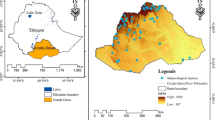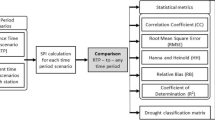Abstract
The Standardized Precipitation Index (SPI) is widely used as a drought meteorological index, to identify drought characteristics including the number of events, frequency, duration, and intensity. In the present study, the SPI is used to detect drought characteristics in spatial and temporal patterns at various timescales of 1, 3, 6, 9, 12, 18, 2-, and 48 months. For this purpose, monthly climatic data from 43 synoptic stations during 1969–2019 were analyzed from Iran’s various climates (coastal wet, mountain, semi mountain, semidesert, desert, and coastal desert). Abrupt and gradual changes in SPI1-48 were detected using the nonparametric Pettitt test and Mann–Kendall (M-K) test separately in the various climates. The M-K results show that a trend was increasingly significant at longer timescales, with the trend of SPI-1 in climates not being significant, while SPI-48 was significant at P less than 0.01 (P < 0.01) at almost all stations in all climates. According to Pettitt’s test results, the changing points of SPI vary between climates and start from Sep. 1992 (SPI1 in semi mountain climates) to Jan. 2004 (SPI48 in desert climates). These results indicate that abrupt changes in the drought index based on SPI, started first in semi mountain and mountain climates in the 1990s and then progressed towards the semidesert and desert climates in the 2000s. The number of drought events changed from 7 in coastal desert stations (Chabahar) to 52 occurrences in coastal wet stations (Bandar Anzali). Spatial distribution of drought intensity shows that drought severity is greater in coastal wet climates than in desert climates. Drought frequency varied from 15.2 to 16.3% at timescales ranging from 1 to 48 months. The mean drought duration was from 12.9 months in semi mountain to 15 months in coastal deserts for SPI1-48. Generally, the study demonstrates the need for more research to select proper timescales for drought indices that are related to climate conditions of given areas.





Similar content being viewed by others
Abbreviations
- CP:
-
Changing point
- D:
-
Drought duration
- ETref :
-
Reference evapotranspiration
- F:
-
Drought frequency
- I:
-
Drought intensity
- IRIMO:
-
Iranian Meteorological Organization of Iran
- M-K:
-
Mann–Kendall test
- P:
-
Precipitation
- RDI:
-
Reconnaissance Drought Index
- SPEI:
-
Standardized Precipitation Evapotranspiration Index
- SPI:
-
Standard precipitation index
- T a :
-
Average air temperature (°C)
- T max :
-
Maximum temperature
- T mean :
-
Average temperature
- T min :
-
Minimum temperature
- u 2 :
-
Average wind speed at 2 m height (m s−1)
- μ 1 :
-
Mutation 1
- μ 2 :
-
Mutation 2
References
Amrit K, Pandey RP, Mishra SK (2018) Assessment of meteorological drought characteristics over Central India. Sustainable Water Resources Management 4(4):999–1010
Belayneh A, Adamowski J, Khalil B (2016) Short-term SPI drought forecasting in the Awash River Basin in Ethiopia using wavelet transforms and machine learning methods. Sustainable Water Resources Management 2(1):87–101
Belayneh A, Adamowski J, Khalil B, Ozga-Zielinski B (2014) Long-term SPI drought forecasting in the Awash River Basin in Ethiopia using wavelet neural network and wavelet support vector regression models. Journal of Hydrology 508:418–429
Bhunia P, Das P, Maiti R (2020) Meteorological drought study through SPI in three drought prone districts of West Bengal, India. Earth Systems and Environment 4(1):43–55
Cheval S, Busuioc A, Dumitrescu A, Birsan MV (2014) Spatiotemporal variability of meteorological drought in Romania using the Standardized Precipitation Index (SPI). Climate Research 60(3):235–248
Dai A (2011a) Characteristics and trends in various forms of the Palmer drought severity index during 1900–2008. J Geophys Res Atmos, 116(D12)
Dai A (2011b) Drought under global warming: a review. Wiley Interdisciplinary Reviews: Climate Change 2(1):45–65
Dashtpagerdi MM, Kousari MR, Vagharfard H, Ghonchepour D, Hosseini ME, Ahani H (2015) An investigation of drought magnitude trend during 1975–2005 in arid and semi-arid regions of Iran. Environmental earth sciences 73(3):1231–1244
Duhan D, Pandey A (2013) Statistical analysis of long term spatial and temporal trends of precipitation during 1901–2002 at Madhya Pradesh, India. Atmos Res 122:136–149
Edossa DC, Babel MS, Gupta AD (2010) Drought analysis in the Awash river basin. Ethiopia. Water resources management 24(7):1441–1460
Goyal MK, Sharma A (2016) A fuzzy c-means approach regionalization for analysis of meteorological drought homogeneous regions in western India. Natural hazards 84(3):1831–1847
Haile GG, Tang Q, Hosseini-Moghari SM et al (2020) Projected impacts of climate change on drought patterns over East Africa. Earth’s Futur 8:1–23. https://doi.org/10.1029/2020EF001502
Hao Z, AghaKouchak A (2013) Multivariate Standardized Drought Index: a parametric multi-index model. Advances in Water Resources 57:12–18
Kaur A, Kumar R (2015) Comparative analysis of parametric and non-parametric tests. Journal of computer and mathematical sciences 6(6):336–342
Kendall MG (1975) Rank correlation methods, 272 S. Charles Griffin Book Series, London
Kousari MR, Dastorani MT, Niazi Y, Soheili E, Hayatzadeh M, Chezgi J (2014) Trend detection of drought in arid and semi-arid regions of Iran based on implementation of Reconnaissance Drought Index (RDI) and application of non-parametrical statistical method. Water resources management 28(7):1857–1872
Liu L, Liao J, Chen X, Zhou G, Su Y, Xiang Z et al (2017) The microwave temperature vegetation drought index (MTVDI) based on AMSR-E brightness temperatures for long-term drought assessment across China (2003–2010). Remote Sensing of Environment 199:302–320
Liu Z, Wang Y, Shao M et al (2016) Spatiotemporal analysis of multiscalar drought characteristics across the Loess Plateau of China. J Hydrol 534:281–299
Lotfirad M, Esmaeili-Gisavandani H, Adib A (2022) Drought monitoring and prediction using SPI, SPEI, and random forest model in various climates of Iran. Journal of Water and Climate Change 13(2):383–406
Mahmoudi P, Ghaemi A, Rigi A, Amir Jahanshahi SM (2021) Recommendations for modifying the Standardized Precipitation Index (SPI) for drought monitoring in arid and semi-arid regions. Water Resources Management 35(10):3253–3275
Mahmoudi P, Rigi A, Kamak MM (2019) A comparative study of precipitation-based drought indices with the aim of selecting the best index for drought monitoring in Iran. Theoretical and Applied Climatology 137(3):3123–3138
McKee TB, Doesken NJ, Kleist J (1993) The relationship of drought frequency and duration to time scales. In Proceedings of the 8th Conference on Applied Climatology 17(22):179–183
Mishra AK, Singh VP (2010) A review of drought concepts. Journal of hydrology 391(1-2):202–216
Mishra AK, Desai VR, Singh VP (2007) Drought forecasting using a hybrid stochastic and neural network model. Journal of Hydrologic Engineering 12(6):626–638
Modarres R, Sarhadi A, Burn DH (2016) Changes of extreme drought and flood events in Iran. Global and Planetary Change 144:67–81
Mohammed R, Scholz M (2017) The Reconnaissance Drought Index: a method for detecting regional arid climatic variability and potential drought risk. Journal of Arid Environments 144:181–191
Noorisameleh Z, Gough WA, Mirza M (2021) Persistence and spatial–temporal variability of drought severity in Iran. Environmental Science and Pollution Research 28(35):48808–48822
Patel NR, Chopra P, Dadhwal VK (2007) Analyzing spatial patterns of meteorological drought using Standardized Precipitation Index. Meteorological Applications: A journal of forecasting, practical applications, training techniques and modelling 14(4):329–336
Pathak AA, Dodamani BM (2019) Trend analysis of groundwater levels and assessment of regional groundwater drought: Ghataprabha River Basin, India. Natural Resources Research 28(3):631–643
Pettitt AN (1979) A non-parametric approach to the change-point problem. J R Stat Soc Ser C Applied Stat 28:126–135
Raziei T, Saghafian B, Paulo AA, Pereira LS, Bordi I (2009) Spatial patterns and temporal variability of drought in western Iran. Water resources management 23(3):439–455
Salarijazi M, Akhond-Ali AM, Adib A, Daneshkhah A (2012) Trend and change-point detection for the annual stream-flow series of the Karun River at the Ahvaz hydrometric station. African Journal of Agricultural Research 7(32):4540–4552
Salmi T (2002) Detecting trends of annual values of atmospheric pollutants by the Mann-Kendall test and Sen's slope estimates-the Excel template application MAKESENS. Ilmatieteen laitos
Sepulcre-Canto G, Horion SMAF, Singleton A, Carrao H, Vogt J (2012) Development of a combined drought indicator to detect agricultural drought in Europe. Natural Hazards and Earth System Sciences 12(11):3519–3531
Serrano R, Mulet JM, Rios G, et al (1999) A glimpse of the mechanisms of ion homeostasis during salt stress. J Exp Bot 1023–1036
Sharafi S, Ghaleni MM (2022) Spatial assessment of drought features over different climates and seasons across Iran. Theoretical and Applied Climatology 145(4):1345–1361
Sneyers R (1990) Onstatistical analysisofseriesof observations. Technical note 143:WMO
Spinoni J, Naumann G, Carrao H et al (2014) World drought frequency, duration, and severity for 1951-2010. Int J Climatol 34:2792–2804. https://doi.org/10.1002/joc.3875
Svoboda M, Hayes M, Wood DA (2012) Standardized precipitation index user guide
Tabari H, Abghari H, Hosseinzadeh Talaee P (2012) Temporal trends and spatial characteristics of drought and rainfall in arid and semiarid regions of Iran. Hydrological Processes 26(22):3351–3361
Tan ML, Chua VP, Li C, Brindha K (2019) Spatiotemporal analysis of hydro-meteorological drought in the Johor River Basin. Malaysia. Theoretical and Applied Climatology 135(3):825–837
Thiel H (1950) A rank-invariant method of linear and polynomial regression analysis, Part 3. In Proceedings of Koninalijke Nederlandse Akademie van Weinenschatpen A (Vol. 53, pp. 1397–1412). Amsterdam, The Netherlands: Royal Netherlands Academy of Arts and Sciences
Wang F, Wang Z, Yang H, Zhao Y (2018) Study of the temporal and spatial patterns of drought in the Yellow River basin based on SPEI. Sci China Earth Sci 61:1098–1111. https://doi.org/10.1007/s11430-017-9198-2
WMO (1966) Measurement and estimation of evaporation and evapotranspiration. technical note no.83; report of a working group on evaporation measurement of the commission for instrument and methods of observation, W.M.O,Geneva, Switzeland
Xu L, Chen N, Zhang X (2019) Global drought trends under 1.5 and 2 C warming. Int J Climatol 39:2375–2385
Zarch MAA, Sivakumar B, Sharma A (2015) Droughts in a warming climate: a global assessment of Standardized Precipitation Index (SPI) and Reconnaissance Drought Index (RDI). Journal of hydrology 526:183–195
Zhai L, Feng Q (2009) Spatial and temporal pattern of precipitation and drought in Gansu Province, Northwest China. Natural hazards 49(1):1
Zhang J, Ding J, Wu P, Tan J, Huang S, Teng D et al (2020) Assessing arid inland lake watershed area and vegetation response to multiple temporal scales of drought across the Ebinur Lake Watershed. Scientific reports 10(1):1–17
Funding
This research did not receive any specific grant from funding agencies in the public, commercial, or not-for-profit sectors.
Author information
Authors and Affiliations
Corresponding author
Ethics declarations
Conflict of interest
The authors declare that they have no competing interests.
Additional information
Responsible Editor: Zhihua Zhang
Rights and permissions
About this article
Cite this article
Sharafi, S., Ghaleni, M.M. & Sadeghi, S. Spatial and temporal analysis of drought in various climates across Iran using the Standardized Precipitation Index (SPI). Arab J Geosci 15, 1279 (2022). https://doi.org/10.1007/s12517-022-10489-5
Received:
Accepted:
Published:
DOI: https://doi.org/10.1007/s12517-022-10489-5




